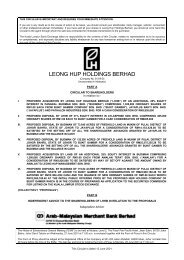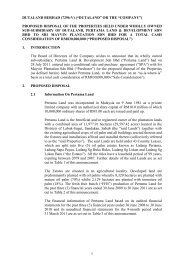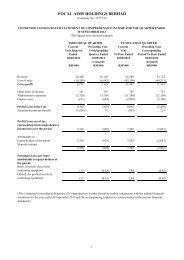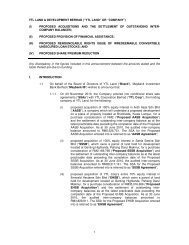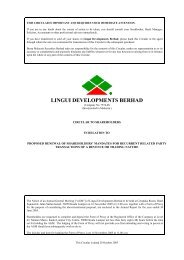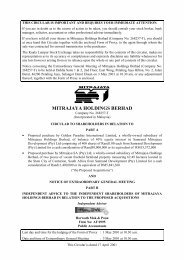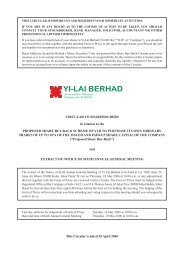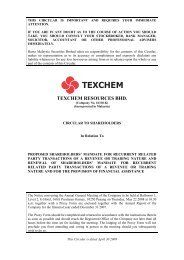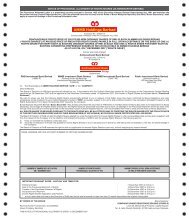MITRA-AnnualReport2011 (1.2MB).pdf - Announcements - Bursa ...
MITRA-AnnualReport2011 (1.2MB).pdf - Announcements - Bursa ...
MITRA-AnnualReport2011 (1.2MB).pdf - Announcements - Bursa ...
You also want an ePaper? Increase the reach of your titles
YUMPU automatically turns print PDFs into web optimized ePapers that Google loves.
Notes to The Financial Statements (cont’d)<br />
2. SUMMARy of SIGNIfICANT ACCoUNTING polICIES (CoNT’D)<br />
2.3 Significant Accounting policies (cont’d)<br />
2.3.12 Impairment of financial Assets (cont’d)<br />
(i) Trade and other receivables and other financial assets carried at amortised cost (cont’d)<br />
If any such evidence exists, the amount of impairment loss is measured as the difference between<br />
the asset’s carrying amount and the present value of estimated future cash flows discounted at the<br />
financial asset’s original effective interest rate. The impairment loss is recognised in profit or loss.<br />
The carrying amount of the financial asset is reduced by the impairment loss directly for all financial<br />
assets with the exception of trade receivables, where the carrying amount is reduced through the use<br />
of an allowance account. When a trade receivable becomes uncollectible, it is written off against the<br />
allowance account.<br />
If in a subsequent period, the amount of the impairment loss decreases and the decrease can<br />
be related objectively to an event occurring after the impairment was recognised, the previously<br />
recognised impairment loss is reversed to the extent that the carrying amount of the asset does not<br />
exceed its amortised cost at the reversal date. The amount of reversal is recognised in profit or loss.<br />
(ii) Unquoted equity securities carried at cost<br />
If there is objective evidence (such as significant adverse changes in the business environment where<br />
the issuer operates, probability of insolvency or significant financial difficulties of the issuer) that<br />
an impairment loss on financial assets carried at cost has been incurred, the amount of the loss is<br />
measured as the difference between the asset’s carrying amount and the present value of estimated<br />
future cash flows discounted at the current market rate of return for a similar financial asset. Such<br />
impairment losses are not reversed in subsequent periods.<br />
(iii) Available-for-sale financial assets<br />
Significant or prolonged decline in fair value below cost, significant financial difficulties of the issuer or<br />
obligor, and the disappearance of an active trading market are considerations to determine whether<br />
there is objective evidence that investment securities classified as available-for-sale financial assets<br />
are impaired.<br />
If an available-for-sale financial asset is impaired, an amount comprising the difference between its<br />
cost (net of any principal payment and amortization) and its current fair value, less any impairment<br />
loss previously recognised in profit or loss, is transferred from equity to profit or loss.<br />
Impairment losses on available-for-sale equity instruments are not reversed in profit or loss in the<br />
subsequent periods. Increase in fair value, if any, subsequent to impairment loss is recognised in other<br />
comprehensive income. For available-for-sale debt investments, impairment losses are subsequently<br />
reversed in profit or loss of an increase in the fair value of the investment can be objectively related to<br />
an event occurring after the recognition of the impairment loss in profit or loss.<br />
2.3.13 Construction Contracts<br />
Where the outcome of a construction contract can be reliably estimated, contract revenue and contract costs<br />
are recognised as revenue and expenses respectively by using the stage of completion method. The stage<br />
of completion is measured by reference to the proportion of contract costs incurred for work performed to<br />
date to the estimated total contract costs.<br />
Where the outcome of a construction contract cannot be estimated reliably, contract revenue is recognised<br />
to the extent of contract costs incurred that are likely to be recoverable. Contract costs are recognised as<br />
expenses in the period in which they are incurred.<br />
<strong>MITRA</strong>JAYA HOLDINGS BERHAD ANNUAL REPORT 2011<br />
53




